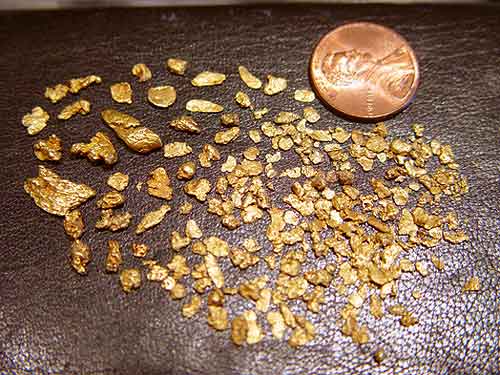Learning to Pan for Gold

In Alaska there is a huge bucket line dredge that moves umpteen yards of gravel per hour. Material is concentrated down and hauled to a cleanup room. Inside this cleanup room, you will find a gold pan. From your huge mining operation all the way down to your individual prospector poking around in the gravel, your gold pan is an essential tool.
They often say don’t call a cowboy a cowboy until you have seen him ride a horse. Well I say don’t call a guy a prospector until you’ve seen him pan.
With the invention of injection molding, we have created some very good pans that make it easy for the beginner and the expert alike to pan for gold. To become proficient at panning it just takes a little patience and some practice. A good way to start is by getting some lead shot and hammering them flat. By hammering them flat, it makes them harder to retrieve and more like flakes of gold. Gold is twice as heavy as lead, so when you are able to save this lead shot inside your gold pan, you can save gold as well.

Here are some of the basic steps. Place your selected gravel in your pan, submerge it completely under water. Use your hands to break up and dissolve clay or mud balls and remove large rocks. Make sure and take care to remove all mud and smaller rocks off of any larger ones. Sometimes you will find flakes of gold will stick to larger pieces of rock. Keep the pan submerged in the water in a semi-liquid condition, not completely under water but not where material will lock up. Everything must be liquefied.
Rotate the pan with a swirling motion to cause the gravel and sand to loosen. Heavier materials will fall to the bottom; lighter materials will come to the top. If you are not too sure about your panning, extra time at this stage can be beneficial. Be sure to aerate the material so your gold will find its way to the bottom of the pan.
Next slowly tilt your pan forward. Most of your modern pans have traps built into them. Find these traps and angle your material with the top of them. Tilt the forward edge slightly down letting dirt, water, light sand and gravel wash over the edge of the pan. Continue the circular swirling motion. You can pause occasionally to rake the top material back into the water, also pick out any larger size rocks.
Do not pour your material out, it is important to keep a semi-liquid condition. If the pan is lifted too high out the water, material will lock up and one must dump or pour the material out of the pan. This is not the right method. Eventually you will have only a small amount of heavy concentrated material left in the riffles of the pan. It is important not to stop too soon and forage around in the pan looking for gold. Continue panning on down until you have a tablespoon full of material.
One must be patient and less vigorous when there is less material in the pan. Start using a gentle but firm side-to-side motion and let the lighter material on top gradually slip over the edge of the pan. You can use one or two hands for this maneuver. When using heavier concentrates, it is important to re-stratify and make the focus of the pan right underneath the first ripple. This is where your gold will concentrate and this is where you want to trap it.
When you are ready for the inspection stage, slowly lower the backside of the pan, dip a small amount of water into the pan and carefully spread the concentrates. Let the water in the pan rotate in a circular motion, this will create an arc of material in your pan, leaving the light stuff at the very end, the heavier black sand in the middle and at the very front of the leading edge your gold.
There is nothing quite like seeing the glimmering shine of real Mother Nature’s treasures in a gold pan. Some people ask me if I ever get tired of panning and the answer is a definite NO! I think it is something like a habitual gambler. Sitting in front of a slot machine putting in quarters and pulling the handle, always wondering what is going to come up next. You shovel the material in the gold pan and pan it down. Sometimes you get nothing and sometimes you hit a jackpot. It’s the thrill of the hunt, always wondering what is going to come out of that next pan.
“Sure Fire Panning” is a video put out by the GPAA that has five different experts showing the tips and tricks of the trade. It’s an excellent video and I highly recommend watching it. It’s an oldie, but a goodie. There is nothing quite like walking up some pristine river with nothing but a gold pan doing a little prospecting. Truly the best way to get better at panning is to do it. Go ahead and get your hands wet.
I am often asked how you can tell if a piece is real gold or fool’s gold. After a while you can tell what it is by the way it acts in a pan, by the way it moves or doesn’t move. Your fool’s gold usually floats around inside of the pan when swirled or is bright and shiny in sunlight but then quickly fades in the shadows. Gold never loses its luster in bright sunlight or in the shadows.
Also, if you are not too sure about your panning, use a safety pan. That is a pan underneath a pan to catch all of the material that comes out of your pan. You can re-pan your materials again, again, and again. But for me, I never need a safety pan, because I never lose any gold out of my pan, HA! If you believe that one then I have a lease I would like you to look into on one of Jupiter’s moons.

